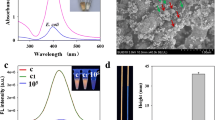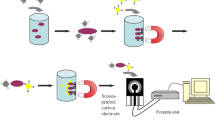Abstract
This research aimed to detect Escherichia coli O157:H7 in milk based on immunomagnetic probe separation technology and quenching effect of gold nanoparticles to Rhodamine B. Streptavidin-modified magnetic beads (MBs) were combined with biotin-modified antibodies to capture E. coli O157:H7 specifically. Gold nanoparticle (AuNPs) was incubated with sulfhydryl-modified aptamers (SH-Aptamers) to obtain the Aptamers-AuNPs probe. After magnetic beads captured target bacteria and formed a sandwich structure with the gold nanoprobe, Rhodamine B was added into complex to obtain fluorescent signal changes. Our results demonstrated that the established method could detect E. coli O157:H7 in the range of 101–107 CFU/mL, and the limit of detection (LOD) was 0.35 CFU/mL in TBST buffer (pH = 7.4). In milk simulation samples, the LOD of this method was 1.03 CFU/mL. Our research provides a promising approach on the detection of E. coli O157:H7.





Similar content being viewed by others
References
Arthur TM, Bosilevac JM, Nou X, Koohmaraie M. Evaluation of culture-and PCR-based detection methods for Escherichia coli O157:H7 in inoculated ground beeft. Journal of Food Protection. 68: 1566-1574 (2005)
Bai H , Bu S , Liu W , Wang C , Li Z , Hao Z , Wan J , Han Y . An electrochemical aptasensor based on cocoon-like DNA nanostructure signal amplification for the detection of Escherichia coli O157:H7. Analyst. 145: 7340-7348 (2020)
Braz VS, Melchior K, Moreira CG. Escherichia coli as a multifaceted pathogenic and versatile bacterium. Frontiers in Cellular and Infection Microbiology. 10: 548492 (2020)
Chen CT, Yu JW, Ho YP. Identification of bacteria in juice/lettuce using magnetic nanoparticles and selected reaction monitoring mass spectrometry. Journal of Food and Drug Analysis. 27: 575-584 (2019)
Chui H, Chan M, Hernandez D, Chong P, McCorrister S, Robinson A, Walker M, Peterson LA, Ratnam S, Haldane DJ, Bekal S, Wylie J, Chui L, Westmacott G, Xu B, Drebot M, Nadon C, Knox JD, Wang G, Cheng K. Rapid, sensitive, and specific Escherichia coli H antigen typing by matrix-assisted laser desorption ionization-time of flight-based peptide mass fingerprinting. Journal of Clinical Microbiology. 53: 2480-5 (2015)
Croxen MA, Law RJ, Scholz R, Keeney KM, Wlodarska M, Finlay BB. Recent advances in understanding enteric pathogenic Escherichia coli. Clinical Microbiology Reviews. 26: 822-880 (2013)
Gieraltowski L, Schwensohn C, Meyer S, Eikmeier D, Medus C, Sorenson A, Forstner M, Madad A, Blankenship J, Feng P, Williams I. Notes from the field: Multistate outbreak of Escherichia coli O157:H7 infections linked to dough mix-United States, 2016. Morbidity and Mortality Weekly Report. 66: 88-89 (2017)
Keba A, Rolon ML, Tamene A, Dessie K, Vipham J, Kovac J, Zewdu A. Review of the prevalence of foodborne pathogens in milk and dairy products in Ethiopia. International Dairy Journal. 109: 104762 (2020)
Kim JH, Yoo JG, Ham JS, Oh MH. Direct Detection of Escherichia coli, Staphylococcus aureus, and Salmonella spp. in animal-derived foods using a magnetic bead-based immunoassay. Korean Journal Food Science Animal Resource. 38: 727-736 (2018)
Li X , Zhao C , Liu Y , Li Y , Lian F , Wang D , Zhang Y , Wang J , Song X , Li J , Yang Y , Xu K. Fluorescence signal amplification assay for the detection of B. melitensis 16M, based on peptide-mediated magnetic separation technology and a AuNP-mediated bio-barcode assembled by quantum dot technology. Analyst. 144: 2704-2715 (2019)
Liu Y, Wei Y, Cao Y, Zhu D, Ma W, Yu Y, Guo M. Ultrasensitive electrochemiluminescence detection of Staphylococcus aureus via enzyme-free branched DNA signal amplification probe. Biosens & Bioelectron. 117: 830-837 (2018)
Luo K, Ryu J, Seol IH, Jeong KB, You SM, Kim YR. Paper-based radial chromatographic immunoassay for the detection of pathogenic bacteria in milk. ACS Applied Materials & Interfaces. 11: 46472-46478 (2019)
Mirhosseini SA, Fooladi AAI, Amani J, Sedighian H. Production of recombinant flagellin to develop ELISA-based detection of Salmonella Enteritidis. Brazilian Journal of Microbiology. 48: 774-781 (2017)
Nancy P, Jose J, Joy N, Valluvadasan S, Philip R, Antoine R, Thomas S, Kalarikkal N. Fabrication of silver-decorated graphene oxide nanohybrids via pulsed laser ablation with excellent antimicrobial and optical limiting performance. Nanomaterials (Basel). 11: 880 (2021)
Ni X, Xia B, Wang L, Ye J, Du G, Feng H, Zhou X, Zhang T, Wang W. Fluorescent aptasensor for 17β-estradiol determination based on gold nanoparticles quenching the fluorescence of Rhodamine B. Analytical Biochemistry. 523: 17-23 (2017)
Parma YR, Chacana PA, Lucchesi PM, Rogé A, Granobles Velandia CV, Krüger A, Parma AE, Fernández-Miyakawa ME. Detection of Shiga toxin-producing Escherichia coli by sandwich enzyme-linked immunosorbent assay using chicken egg yolk IgY antibodies. Frontiers in Cellular and Infection Microbiology. 2: 84 (2012)
Priyanka B, Patil RK, Dwarakanath S. A review on detection methods used for foodborne pathogens. The Indian Journal of Medical Research. 144: 327-338 (2016)
Srinivasan S, Ranganathan V, DeRosa MC, Murari BM. Label-free aptasensors based on fluorescent screening assays for the detection of Salmonella Typhimurium. Analytical Biochemistry. 559: 17-23 (2018)
Su C, Brandt LJ. Escherichia coli O157:H7 infection in humans. Annals of Internal Medicine. 123: 698-714 (1995)
Sun S, Ding Z, Yang X, Zhao X, Zhao M, Gao L, Chen Q, Xie S, Liu A, Yin S, Xu Z, Lu X. Nanobody: A small antibody with big implications for tumor therapeutic strategy. International Journal of Nanomedicine. 16: 2337-2356 (2021)
Wang D, Lian F, Yao S, Liu Y, Wang J, Song X, Ge L, Wang Y, Zhao Y, Zhang J, Zhao C, Xu K. Simultaneous detection of three foodborne pathogens based on immunomagnetic nanoparticles and fluorescent quantum dots. ACS Omega. 5: 23070-23080 (2020)
Wu Q, Zhang Y, Yang Q, Yuan N, Zhang W. Review of electrochemical DNA biosensors for detecting food borne pathogens. Sensors. 19: 4916- (2019)
Xu D, Ji L, Wu X, Yan W, Chen L. Detection and differentiation of Vibrio parahaemolyticus by multiplexed real-time PCR. Canadian Journal of Microbiology. 64: 809-815 (2018)
Yilmaz E, Sarp G, Uzcan F, Ozalp O, Soylak M. Application of magnetic nanomaterials in bioanalysis. Talanta. 229: 122285 (2021)
Zhang J, Liu B, Liu H, Zhang X, Tan W. Aptamer-conjugated gold nanoparticles for bioanalysis. Nanomedicine (Lond). 8: 983-93 (2013)
Zhang D, Yang J, Ye J, Xu L, Xu H, Zhan S, Xia B, Wang L. Colorimetric detection of bisphenol A based on unmodified aptamer and cationic polymer aggregated gold nanoparticles. Analytical Biochemistry. 499: 51-56 (2016)
Zhang M, Xu X, Gu Y, Cheng X, Hu J, Xiong K, Jiang Y, Fan T, Xu JM. Zhang, M., Xu, X., Gu, Y., Cheng, X., Hu, J., Xiong, K., Jiang, Y., Fan, T., & Xu, J. Porous and nanowire-structured NiO/AgNWs composite electrodes for significantly-enhanced supercapacitive and electrochromic performances. Nanotechnology. 32: (2021)
Zhao X, Lin CW, Wang J, Oh DH. Advances in rapid detection methods for foodborne pathogens. Journal of Microbiology and Biotechnology. 24: 297-312 (2014)
Zhao Y, Zeng D, Yan C, Chen W, Ren J, Jiang Y, Jiang L, Xue F, Ji D, Tang F, Zhou M, Dai J. Rapid and accurate detection of Escherichia coli O157:H7 in beef using microfluidic wax-printed paper-based ELISA. Analyst. 145: 3106-3115 (2020)
Zhu P, Shelton DR, Li S, Adams DL, Karns JS, Amstutz P, Tang CM. Detection of E. coli O157:H7 by immunomagnetic separation coupled with fluorescence immunoassay. Biosensors & Bioelectronics. 30: 337-341 (2011)
Acknowledgements
This work was financially supported by the Jilin Province Development and Reform Commission (the Grant Number: 2020C038-7), the Development of Science and Technology, Jilin Province, China (Grant Number: 2018010195JC), National Natural Science Foundation of China (Grant Number: 81401721), the Education Department of Jilin Province, China (Grant Number: JJKH20180239KJ) and the Health and Family Planning Commission of Jilin Province (Grant Number: 2017J074)
Author information
Authors and Affiliations
Contributions
FL, KX, CZ conceived and designed the study. FL, DW, SY, lirui Ge performed the assay of experimental detection. JZ, YZ and YW analyzed the data. FL drafted the manuscript. CZ and XS provided constructive opinions and suggestions. KX, CZ, XS, YL, JL and MJ reviewed and made improvements in the manuscript. All authors read and approved the final version of the paper.
Corresponding author
Ethics declarations
Conflicts of interest
On behalf of all authors, the corresponding author states that there is no conflict of interest.
Additional information
Publisher's Note
Springer Nature remains neutral with regard to jurisdictional claims in published maps and institutional affiliations.
Rights and permissions
About this article
Cite this article
Lian, F., Wang, D., Yao, S. et al. A detection method of Escherichia coli O157:H7 based on immunomagnetic separation and aptamers-gold nanoparticle probe quenching Rhodamine B’s fluorescence. Food Sci Biotechnol 30, 1129–1138 (2021). https://doi.org/10.1007/s10068-021-00947-3
Received:
Revised:
Accepted:
Published:
Issue Date:
DOI: https://doi.org/10.1007/s10068-021-00947-3




